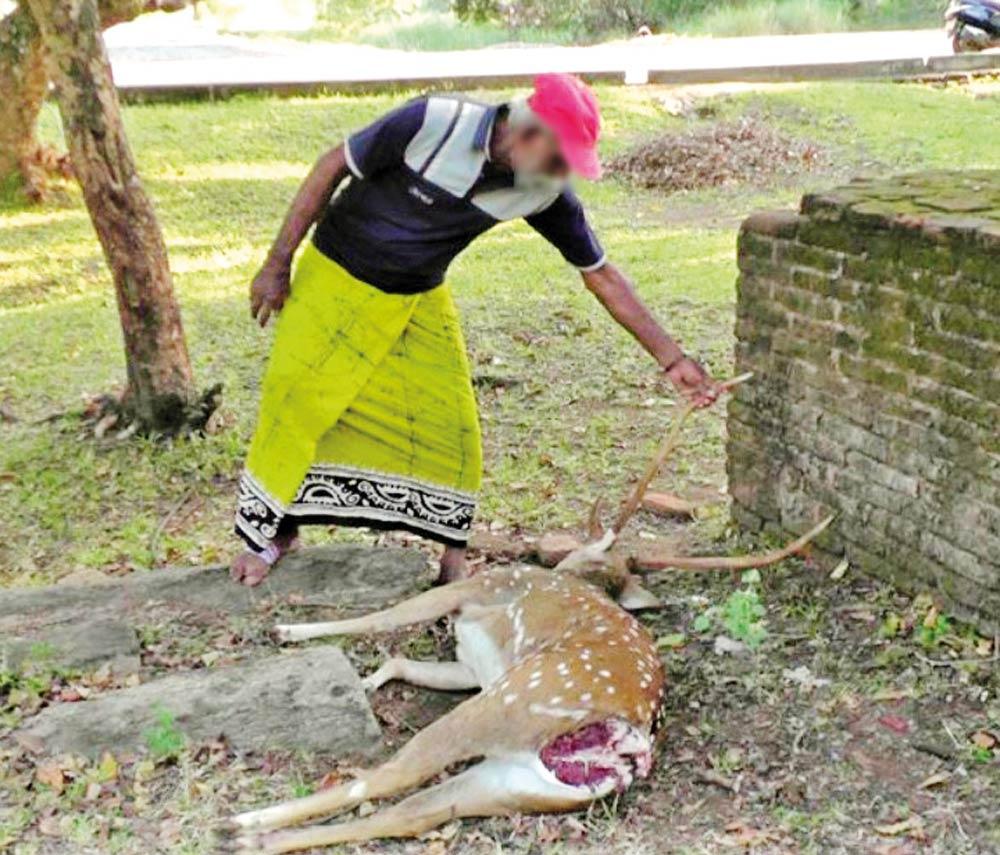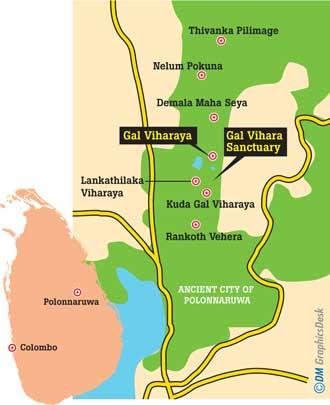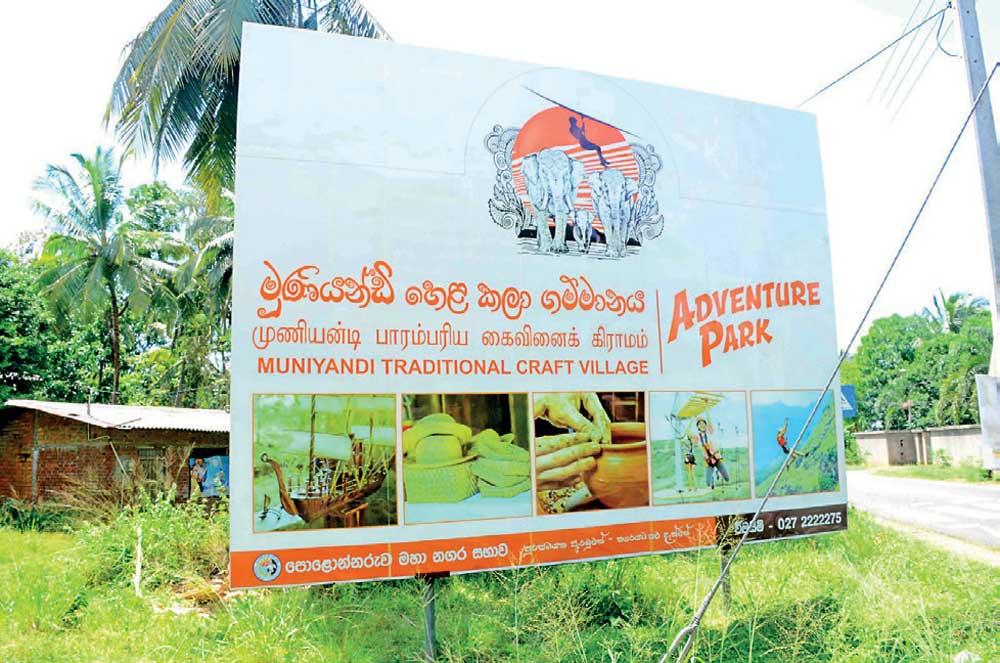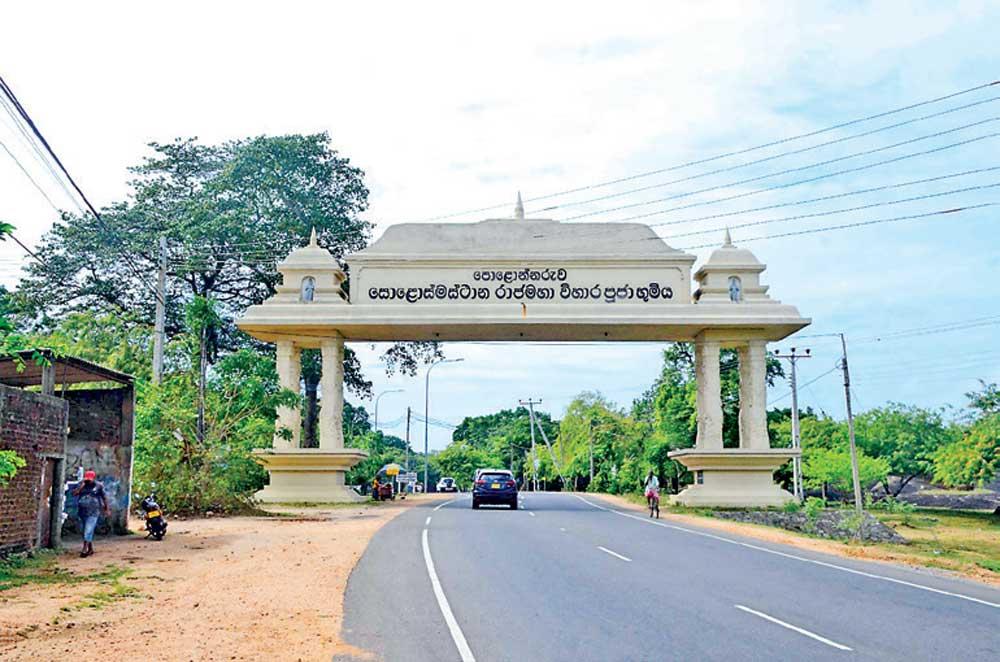Reply To:
Name - Reply Comment

The carcass of a deer, which was caught in a trap set up by hunters
 Recognising the archaeological and historical significance of the area around Polonnaruwa Gal Vihara, the British rulers designated it as a reserve and sanctuary on May 27, 1937 to protect it for the future. The sanctuary, covering an area of 1,521 hectares, is currently inhabited, but wild animals too roam around. Many of these animal species are now facing the threat of extinction due to modern poachers, who hunt them for venison.
Recognising the archaeological and historical significance of the area around Polonnaruwa Gal Vihara, the British rulers designated it as a reserve and sanctuary on May 27, 1937 to protect it for the future. The sanctuary, covering an area of 1,521 hectares, is currently inhabited, but wild animals too roam around. Many of these animal species are now facing the threat of extinction due to modern poachers, who hunt them for venison.
 There is a growing trend to hunt wild animals in the Polonnaruwa Gal Vihara Sanctuary. An investigation done by this newspaper revealed that these animals are being hunted using licensed guns or air rifles. Additionally, hunting practices include setting traps, placing Hakka Patas (An explosive that bursts inside the mouth), using dogs to chase and kill animals after they (animals) are trapped within the protective fence surrounding the Gal Vihara. During our visit, this writer observed that efforts to stop the killing of wild animals in this manner have been unsuccessful.
There is a growing trend to hunt wild animals in the Polonnaruwa Gal Vihara Sanctuary. An investigation done by this newspaper revealed that these animals are being hunted using licensed guns or air rifles. Additionally, hunting practices include setting traps, placing Hakka Patas (An explosive that bursts inside the mouth), using dogs to chase and kill animals after they (animals) are trapped within the protective fence surrounding the Gal Vihara. During our visit, this writer observed that efforts to stop the killing of wild animals in this manner have been unsuccessful.
Due to the delay in enforcing the law against such illegal hunting practices, modern poachers in Polonnaruwa are mercilessly killing animals. Not only are they committing these unlawful acts, they also boast about their sinful crimes at gatherings. During a recent visit to Polonnaruwa to gather information about animal hunting, this newspaper learned that just a few days ago, a deer had been shot and killed within the area of the Gal Vihara sanctuary. Those behind the killing were seen discussing how to share the 20 kilograms of meat left from the deer carcass and how to use it.
|
“In the past, deer were shot and killed, but after establishing a police post and tightening security measures, along with constant monitoring by wildlife officers, such incidents have significantly reduced,”
“Without receiving formal complaints it’s a challenge to conduct an investigation. The sanctuary falls under the jurisdiction of the Athumalpitiya East Division” |
Today, animals such as hare, mouse deer, wild boar, porcupine and deer have fallen prey to these modern poachers in the Polonnaruwa Sanctuary. Our investigation revealed that wild boars no longer exist in this sanctuary, as they have become victims of traps and shootings. Wildlife officials confirmed this information and pointed out that animals like hare and mouse deer have already become extinct in the Polonnaruwa sanctuary area.

Muniyandi Traditional Craft Village’ which is infamous for poaching activities
As a result, modern poachers have shifted their focus to deer; targeting them to satisfy the venison cravings of local tourists visiting Polonnaruwa. Reports indicate that venison smuggling is conducted on a large scale within the Polonnaruwa district.
This type of illegal activity has been continuing for 8 to 10 years. Though in the past, a person might have hunted an animal out of necessity to meet the basic need for food, deer hunting has now become a hobby and necessity of the elite. Those who once set traps or used Hakka Patas to catch wild animals now use their licensed guns or air rifles to hunt; individuals taking to such activity as mere entertainment. Once every two to three days, a deer, porcupine, hare or even a mouse deer is hunted. No law enforcement officer in Polonnaruwa has been able to stop this criminal activity. It is evident from the inaction of the authorities that they have not taken any steps to put an end to this immoral practice.

A fence built around Polonnaruwa Gal Vihara
No chance to escape
|
Fences broken near ‘Muniyandi Traditional Craft Village’ to lure deer to the area
|
An iron fence has been erected to protect the Polonnaruwa Gal Vihara site. However there are gaps between the wires which are less than three inches wide. Once animals from the sanctuary enter the Gal Vihara site in search of water, they cannot slip through the wired fence. If a deer is suddenly chased toward the fence by a dog or a human, it becomes trapped with no chance to escape. Some people wait for this moment to hunt down the deer.
In some cases, when dogs chase deer, which are searching for water, these animals which are hunted get stuck in the iron fence and are attacked by the dogs. Sometimes these activities bring death to the hunted animals. Our investigations also revealed that deer trapped in the safety fence are sometimes beaten on the head with wooden sticks, strangled with wires, or shot before being killed.
As a result, the lives of wild animals in the Polonnaruwa sanctuary are in serious danger. The Department of Wildlife and Conservation (DWC) has repeatedly stated, both in writing and verbally, that the iron fence, built at a cost of millions of rupees, is not serving the intended purpose of protecting the sanctuary. However, despite informing the relevant authorities, no proper response has been received. The DWC alleges that this iron fence was constructed to cater to an individual’s personal agenda. Consequently, this fence has become a death trap for deer and other animals roaming both the Polonnaruwa Gal Vihara and the sanctuary.
Additionally, there is an allegation that deer entering the land of ‘Muniyandi Traditional Craft Village’ which is located within the Polonnaruwa Sanctuary area, are being hunted using traps. It has been reported that the wire fence erected to protect the craft village has been removed in certain areas. This has allowed easy access for deer, who are then targeted using traps before being killed.
Our investigations revealed that security personnel from the police and the Department of Archaeology are stationed to strengthen the security at Gal Vihara. Given such a situation, it is difficult to fathom how such a series of criminal activities can take place. Wildlife officials said that if the homes and premises of certain individuals in charge of certain religious sites, archaeological site guards and officers in charge of public safety are inspected there is a great possibility finding illegal venison. Additionally, it has been confirmed that the Polonnaruwa Galvihara Sanctuary is the only sanctuary in the area without a regional wildlife office dedicated to its protection.
|
There is a growing trend to hunt wild animals in the Polonnaruwa Gal Vihara Sanctuary
|
a prominent figure in the Galvihara sanctuary area had opposed the idea, stating, “Don’t try to turn this into a zoo by setting up a wildlife office,”. Due to this leader’s influence, the project was halted. About two years ago, a person who handed over a deer that had been hit by a vehicle in Athumalpitiya to the Giritale Wildlife Office was later informed that the deer had died when he visited the office. When he asked the wildlife officials where the deer had been buried, they were unable to show him the location. In another incident, when wildlife officers delayed in treating a critically injured deer, caught in a trap, locals from Athumalpitiya called the police. The law enforcement officers then transported the deer in a police jeep and handed it over to the wildlife officers. Later, a local resident inquired with the police about the condition of the deer. The police claimed that the deer had jumped out of the jeep and ran into the lake embankment at Parakrama Samudra. However, they said that there have been no reports of a deer escaping or being found injured after that.

A pandol constructed near the entrance to the sacred temple city of Polonnaruwa
Additionally, while efforts were being made to rescue a deer trapped in the protective fence of the Gal Vihara, an influential person from the nearby area took the deer. Following an investigation into a complaint received by the wildlife officers, deer meat was discovered in the refrigerator of this influential person’s residence. However, local residents alleged that no legal action was taken by the wildlife officials regarding this matter. Furthermore, an officer connected to the defence establishment, who had been hunting deer and other wild animals while working to protect the Gal Vihara, recently died from kidney disease after much suffering. It is also well-known among the people of Polonnaruwa that this individual had been supplying venison to some hotels in the Habarana area.
Polonnaruwa hotels stop purchasing venison
In addition, some hotels in the Polonnaruwa area have stopped purchasing venison due to concerns that, if the law is enforced when deer die on a large scale, they could face legal problems. However, it is known that deer meat from the Polonnaruwa sanctuary is still available for sale in Habarana and Girithale. In Polonnaruwa, venison is regularly cooked in homes. It is also known that in some houses, which are labelled as elite, venison is served during all three meals of the day.
There are several access points to the Gal Vihara for poachers. One entrance is from the roads leading to the Athumalpitiya area, which provides access to the back of the Gal Vihara. Another entry point is from the Polonnaruwa hospital side, behind the railway station. One can go down the Deke Ela and cross it to reach the sanctuary. This area lacks a proper security point or guards and is known to be desolate, with wild animals roaming freely. Additionally, there is a group of people who trap deer in the Galtambara area.
From the road near the Bendiwewa fuel station, one can access the Sudukanda area in Tambala Wewa, where deer are abundant. Deer in the sanctuary are being killed using traps and sold as venison, with false claims being made that they are from Sudukanda. Some people believe there is no issue with consuming or keeping venison with them, as the Sudukanda area is quite remote.
The Polonnaruwa Sanctuary area is currently managed by the Polonnaruwa Range Office. This area is located in the Manampitiya area or in Egoda Paththuwa. The DWC Office is located in Girithale. By the time wildlife officers from these offices respond to calls, illegal activities have already occurred. Therefore, there is an urgent need for responsible authorities to quickly establish a wildlife range office in the Polonnaruwa Galvihara Sanctuary to ensure the protection of wild animals. It is the duty of the authorities to safeguard these creatures
According to the Fauna and Flora Protection Ordinance No. 2 of 1939, it is illegal to enter a sanctuary or reserve with the intention of setting traps or shooting wild animals using air rifles or licensed guns. Carrying a gun into a sanctuary, and firing it is also a crime. Killing an animal within a sanctuary is an offence, with fines varying depending on the species killed. These offences are punishable individually, with additional penalties including imprisonment of not less than two years and up to five years.
For instance, if a deer is killed within a sanctuary, the fine ranges from 20,000 to 50,000 rupees. Carrying a firearm into a sanctuary incurs a fine of 20,000 to 100,000 rupees. If a shot is fired from the firearm, another fine of 20,000 to 100,000 rupees is imposed. If that shot results in the death of a deer, an additional fine of 20,000 to 50,000 rupees is imposed.
While there are laws in place to protect wild animals, the issue lies in the inadequate enforcement of these laws. This failure allows modern poachers to ‘eat’ into the deer population in the Polonnaruwa sanctuary.
This newspaper spoke to officers from the Gal Vihara Police Station to obtain a comment regarding the peaching issue. An officer at the Police station said, “Deer deaths in the Gal Vihara area have decreased, as we now conduct 24-hour patrols. However, deer leave the sacred area to drink water and they get killed by traps, made using wires of three-wheeler metres. Although the front portion of the Gal Vihara area is fenced, there is no fence behind it. The villages border the forest and in those areas there are traps set to hunt deer. We conducted a raid two months ago, capturing three suspects involved in poaching deer and fined them 168,000 rupees. Now the poaching activities inside the sanctuary have decreased, but deer continue to be hit by vehicles outside the sacred area. These injured or killed deer are often transported in vehicles without these incidents being reported. And if a deer is found injured within the sanctuary, we document the details of the vehicle and the officials who come to retrieve the deer before handing it over to the wildlife authorities.”
This newspaper also spoke with Kandaketiye Aththadassi Thera, the Chief Incumbent of Polonnaruwa Galvihara regarding the situation. Aththadassi Thera stated that deer no longer die due to the fence in the Gal Vihara grounds, and there is currently no such problem. “In the past, deer were shot and killed, but after establishing a police post and tightening security measures, along with constant monitoring by wildlife officers, such incidents have significantly reduced,” Aththadassi Thera said.
This writer also inquired about the situation with Shyama Priyadarshani Grama Niladhari officer of Athumalpitiya West. Priyadarshani said that there has been speculation about deer being shot and killed. “However without receiving formal complaints it’s a challenge to conduct an investigation. The sanctuary falls under the jurisdiction of the Athumalpitiya East Division,” she said. This is the area where most deer killings have been reported from.
Attempts were made to contact Polonnaruwa District Secretary Ajantha Ekanayake, but he was unavailable for comment.
Regarding the allegations of setting up traps to kill deer inside Muniyandi Craft Village, Polonnaruwa Municipal Commissioner K. Chandima Niroshani said, “No evidence supporting the accusation was found. The fences of the boundary of the craft village, which had been demolished, have now been restored”.
|
“Everything is delayed due to a lack of personnel”-Edirisinghe
W.L.P Edirisinghe, Assistant Director of the Department of Wildlife and Conservation Polonnaruwa, provided the following response to use queries: “Deer are being shot and killed using traps. When we receive information, we conduct raids, and bring them (hunters) before courts to enforce the law. However, practical challenges prevent the establishment of a wildlife office in the Polonnaruwa Gal Vihara sanctuary area, primarily due to a shortage of officers. There are many areas that require protection, and everything is delayed because of this lack of personnel. Wildlife officers are responsible for protecting wild animals, and those tasked with this duty ensure that sick deer are cared for and not butchered and eaten. Additionally, the safety fence around the Gal Vihara is very old and does obstruct deer, but it cannot be stated that the fence poses a significant danger to them.” |